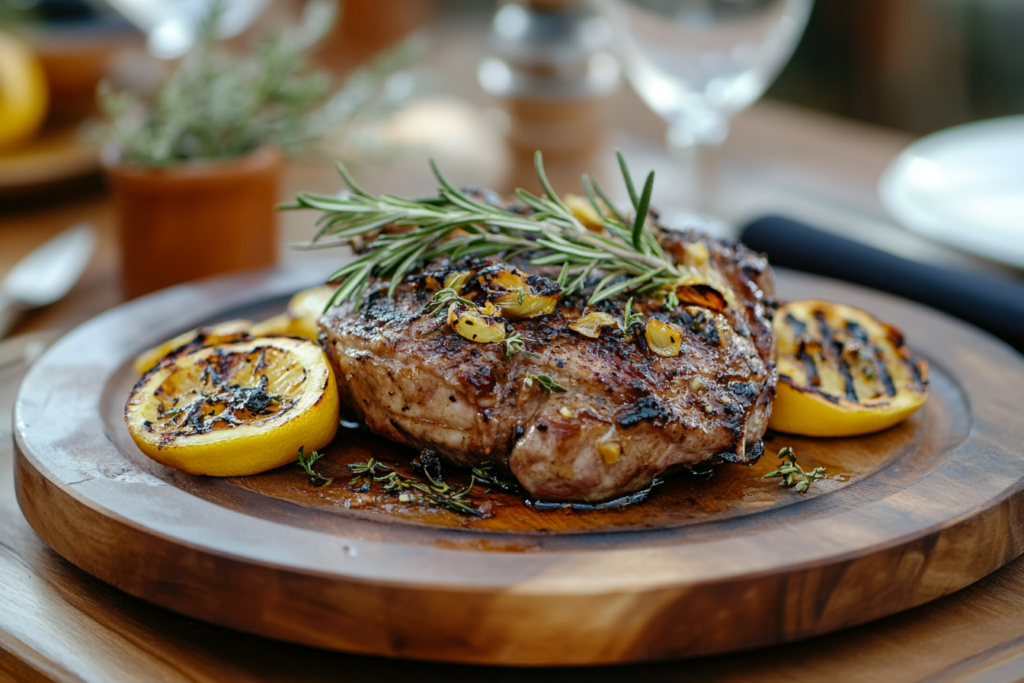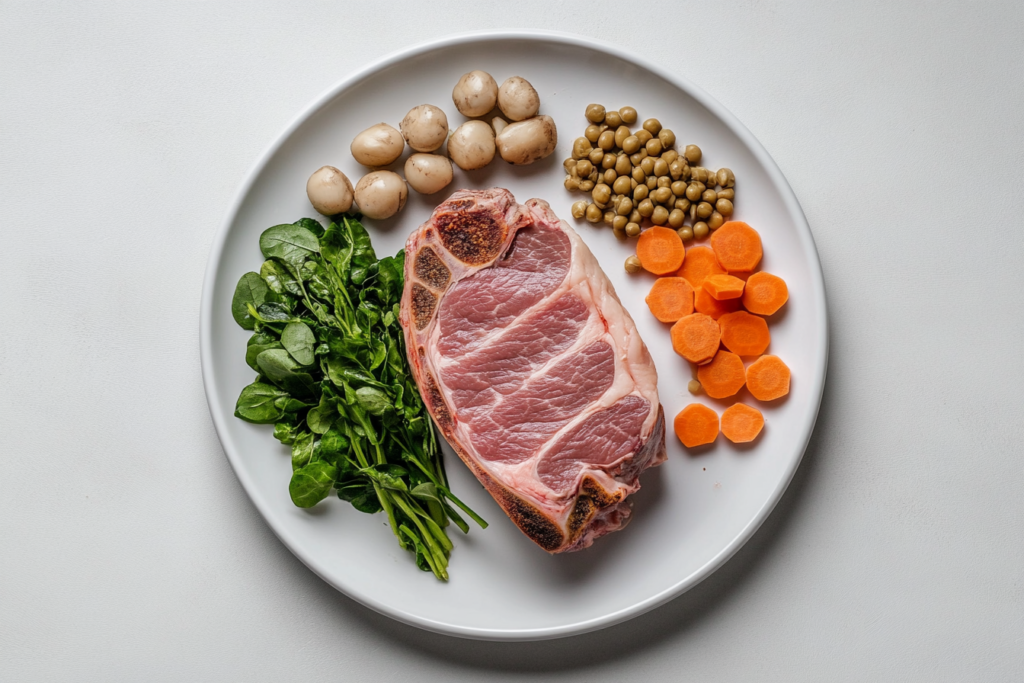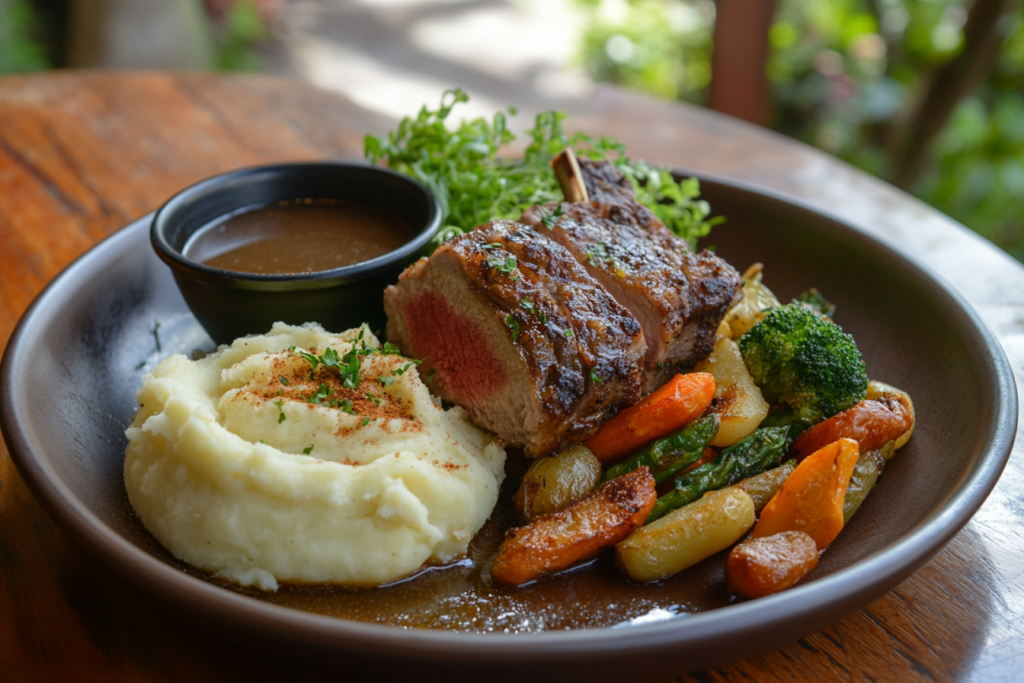Introduction

Lamb breast plate is a flavorful and versatile cut of meat that often flies under the radar in the culinary world. Despite being less popular than lamb chops or legs, it has gained recognition for its rich taste and affordability. Whether roasted, braised, or grilled, this cut offers endless possibilities for creating delicious meals.
Known for its marbled fat and layers of tender meat, the lamb breast plate is ideal for slow cooking, allowing its natural flavors to develop fully. It’s a fantastic option for both everyday dinners and special occasions, providing a budget-friendly alternative to pricier cuts.
In this guide, we’ll explore everything you need to know about the lamb breast plate. From understanding its characteristics and alternative names to cooking techniques and pairing ideas, this article will leave you well-prepared to make the most of this savory cut. Let’s dive into the world of lamb breast plate!
Understanding Lamb Breast Plate
Lamb breast plate is a flavorful and economical cut of meat that comes from the lower chest area of the lamb. It’s well-known for its rich taste, thanks to its marbled fat and layers of muscle. Often overlooked, this cut can be transformed into a tender and mouthwatering dish when cooked properly.
What Is Lamb Breast Plate?
The lamb breast plate refers to the meaty portion located near the ribs and belly of the lamb. It’s a relatively flat cut, often containing a good balance of fat and lean meat, which contributes to its juicy and tender texture after slow cooking.
Due to its structure, lamb breast plate is best suited for recipes that involve roasting, braising, or smoking. These cooking techniques allow the fat to render slowly, enriching the flavor of the meat while keeping it moist.
What Is Another Name for Lamb Breast?
Lamb breast is sometimes referred to by other names, depending on the region or butcher terminology. Common alternatives include:
- Lamb Brisket: Because of its position on the lower chest, it’s often compared to beef brisket.
- Lamb Belly: Highlighting its connection to the lamb’s underside.
- Lamb Plate Ribs: Particularly when the rib bones are still attached.
Understanding these names can be helpful when shopping for lamb breast in different markets or recipes.
Cooking Lamb Breast Plate
Cooking lamb breast plate is a rewarding experience, especially if you enjoy rich, tender meat with layers of flavor. Because of its slightly tougher texture, this cut is ideal for slow-cooking methods that allow the fat to render and the meat to soften. Let’s explore the best techniques for preparing this cut.
How to Cook Lamb Breast Plate
Cooking lamb breast plate requires patience, but the results are well worth it. Here’s a step-by-step guide to help you create a delicious dish:
- Preparation:
- Trim any excess fat, but leave enough to keep the meat moist during cooking.
- Score the fat layer lightly to allow seasonings and marinades to penetrate.
- Seasoning:
- Rub the lamb breast with salt, pepper, garlic, and herbs like rosemary and thyme.
- For deeper flavor, marinate the meat overnight in olive oil, lemon juice, garlic, and spices.
- Cooking Methods:
- Roasting: Preheat the oven to 325°F (163°C). Place the lamb breast on a rack in a roasting pan, fat-side up, and cook for 2–3 hours until the meat is tender and the fat is crispy. Baste occasionally to keep it moist.
- Braising: Brown the meat in a hot pan, then transfer it to a pot with broth, onions, carrots, and celery. Cover and simmer for 2–3 hours until the meat is fall-apart tender.
- Grilling: For a smoky flavor, grill the lamb breast over medium heat, turning occasionally until golden brown and cooked through (about 20–30 minutes).
- Resting and Serving:
- Let the cooked lamb rest for 10 minutes before slicing.
- Serve with roasted vegetables, mashed potatoes, or a side salad for a complete meal.
How to Cook Split Lamb Breast Plate
Split lamb breast plate, where the meat is separated into smaller sections, is perfect for quick cooking methods or recipes requiring more surface area for marinades.
- Preparation:
- Cut the split breast into smaller pieces if needed.
- Marinate for 1–2 hours with olive oil, garlic, lemon zest, and paprika.
- Cooking Methods:
- Slow-Cooking: Place the split breast in a slow cooker with broth, vegetables, and seasonings. Cook on low for 6–8 hours until tender.
- Pan-Frying: Sear the pieces in a hot skillet with butter and garlic for 10–15 minutes, turning until crispy.
- Air-Frying: For a healthier option, air-fry at 375°F (190°C) for 25–30 minutes, flipping halfway through.
- Serving Ideas:
- Pair with dipping sauces like mint yogurt or chimichurri for added flavor.
Texture and Taste of Lamb Breast
Lamb breast is loved for its rich flavor and tender texture when cooked correctly. It’s a cut that benefits from slow cooking methods, allowing the fat to melt and infuse the meat with moisture and taste. Let’s dive into the details about its texture and taste.
Is Lamb Breast Chewy?
Lamb breast can be chewy if it’s not cooked properly due to its connective tissues and fat layers. However, this toughness can be easily transformed into softness with slow-cooking techniques like braising or roasting.
- Slow Cooking for Tenderness: Low and slow heat helps break down collagen, resulting in melt-in-your-mouth tenderness.
- Marinating for Flavor: Using acidic marinades with ingredients like lemon juice or vinegar helps tenderize the meat before cooking.
- Crispy Finish: After slow-cooking, you can finish the lamb under a broiler or on a grill to achieve a crispy crust while keeping the inside juicy.
When prepared with patience, lamb breast delivers a satisfying bite, combining softness and crunchiness in one dish.
Nutritional Benefits of Lamb Breast Plate
Besides its delicious taste, lamb breast plate provides a variety of nutritional benefits, making it a great addition to your diet in moderation.

Protein and Vitamin Content
Lamb breast is a rich source of protein, which supports muscle growth and repair. It also contains essential vitamins and minerals, such as:
- Vitamin B12: Important for nerve function and red blood cell production.
- Zinc: Boosts immune function and promotes wound healing.
- Iron: Supports oxygen transport in the blood and prevents anemia.
Fat Content and Calories
Lamb breast is a fatty cut, which contributes to its intense flavor. While it’s higher in calories, it also provides healthy fats, including:
- Monounsaturated Fats: Known for improving heart health.
- Conjugated Linoleic Acid (CLA): Believed to have anti-inflammatory properties and potential fat-burning effects.
Nutritional Breakdown (Per 100g):
- Calories: Approximately 320–350 kcal
- Protein: 15–17g
- Fat: 28–30g
- Iron: 1.8 mg
- Zinc: 3.9 mg
Although lamb breast is rich in fats, its nutrient density makes it a great choice when consumed in moderation as part of a balanced diet. For comparisons, you can explore whether lamb is healthier than beef to make informed dietary choices.
Best Seasonings and Marinades for Lamb Breast
The rich and savory flavor of lamb breast plate pairs beautifully with a variety of seasonings and marinades. Proper seasoning enhances its natural taste, while marinades tenderize the meat and add layers of flavor.
Herbs and Spices for Lamb
Lamb breast is highly versatile, making it easy to pair with herbs and spices that elevate its flavor. Here are some popular choices:
- Herbs:
- Rosemary: Complements lamb’s earthy flavor.
- Thyme: Adds a subtle, woody aroma.
- Mint: Provides a refreshing contrast to the richness of lamb.
- Oregano: Offers a Mediterranean touch.
- Spices:
- Garlic Powder: Intensifies flavor and aroma.
- Cumin: Brings a warm, smoky essence.
- Paprika: Adds mild heat and vibrant color.
- Coriander: Provides citrusy undertones.
These herbs and spices can be used in rubs or sprinkled directly on the meat before roasting or grilling.
Marinade Recipes for Lamb Breast Plate
Marinating lamb breast plate not only tenderizes the meat but also locks in flavor. Here are two quick and easy marinade recipes:
- Garlic and Herb Marinade:
- Ingredients:
- 3 cloves garlic (minced)
- 2 tablespoons olive oil
- 1 tablespoon lemon juice
- 1 teaspoon rosemary
- 1 teaspoon thyme
- Salt and pepper to taste
- Instructions:
- Combine ingredients in a bowl.
- Rub the mixture evenly over the lamb breast.
- Marinate for at least 4 hours (or overnight) in the refrigerator.
- Ingredients:
- Mediterranean Marinade:
- Ingredients:
- 1/4 cup Greek yogurt
- 2 tablespoons olive oil
- 1 teaspoon cumin
- 1 teaspoon paprika
- 1 teaspoon oregano
- 1 clove garlic (crushed)
- Instructions:
- Mix ingredients until smooth.
- Coat the lamb breast and marinate for 6–8 hours before cooking.
- Ingredients:
These marinades not only boost flavor but also tenderize the meat, ensuring a juicy and satisfying dish.
Pairing Lamb Breast with Side Dishes
Choosing the right side dishes can elevate your lamb breast plate into a well-rounded meal.

Vegetable Sides
Vegetables add freshness and balance to the rich flavors of lamb. Popular options include:
- Roasted Root Vegetables: Carrots, parsnips, and potatoes roasted with olive oil and herbs.
- Grilled Asparagus: Light and crispy, with a hint of smokiness.
- Steamed Green Beans: Tossed with butter and garlic for added flavor.
- Mixed Green Salad: A refreshing option with a lemon vinaigrette.
Grains and Starches
Grains and starches provide a hearty base to complement the meat’s richness:
- Mashed Potatoes: Creamy and buttery, a perfect match for lamb breast.
- Couscous or Quinoa: Light and fluffy grains with herbs and dried fruits for a Mediterranean feel.
- Rice Pilaf: Infused with spices like saffron or turmeric for extra flavor.
These sides create a balanced meal that highlights the flavors of the lamb breast plate without overpowering it.
Storage and Reheating Tips
Proper storage and reheating techniques ensure that leftover lamb breast plate retains its flavor and texture. Whether you’re saving it for later or meal-prepping, following these tips can make a big difference.
Refrigeration and Freezing
Refrigeration:
- Short-Term Storage: Store cooked lamb breast in an airtight container in the refrigerator. It will stay fresh for up to 3–4 days.
- Preparation Tip: Allow the meat to cool to room temperature before sealing it in containers.
Freezing:
- Long-Term Storage: Wrap the lamb breast tightly in plastic wrap, followed by aluminum foil, or place it in a freezer-safe bag.
- Storage Duration: It can be frozen for up to 3 months without losing flavor.
- Thawing Instructions: Thaw overnight in the refrigerator before reheating to preserve moisture.
Reheating Without Drying Out
Oven Method (Best for Large Portions):
- Preheat the oven to 300°F (150°C).
- Wrap the lamb breast in foil with a splash of broth or water to add moisture.
- Heat for 15–20 minutes until warmed through.
Stovetop Method (Quick and Easy):
- Slice the lamb breast into smaller pieces.
- Heat a skillet over medium heat and add a bit of oil or butter.
- Cook for 5–7 minutes, flipping occasionally until evenly heated.
Microwave Method (For Convenience):
- Place the lamb on a microwave-safe plate and cover it with a damp paper towel.
- Heat in 30-second intervals, checking frequently to avoid drying out the meat.
These methods preserve the tenderness of the lamb while bringing it back to serving temperature.
FAQs
Is Lamb Breast a Good Cut?
Yes, lamb breast is a great cut, especially for slow-cooked recipes. It’s affordable, flavorful, and develops a tender texture when cooked properly. Its rich fat content makes it ideal for roasting and braising.
Is Lamb Breast the Same as Lamb Ribs?
No, lamb breast and lamb ribs are slightly different cuts. While the lamb breast comes from the lower chest area, lamb ribs are typically the portion with more exposed rib bones. However, they are closely related and can sometimes be used interchangeably in recipes.
What Is the Tastiest Cut of Lamb?
The tastiest cut of lamb depends on personal preference, but popular options include:
- Lamb Shoulder: Rich in flavor and ideal for slow cooking.
- Lamb Chops: Tender and perfect for quick grilling.
- Lamb Leg: Lean and versatile, often used for roasting.
- Lamb Breast: Known for its marbled fat and deep flavor, especially when slow-cooked.
Many consider lamb loin roast and leg of lamb as the tastiest cuts due to their tenderness and versatility.
How to Cook a Lamb Breast Plate?
Cooking lamb breast involves slow roasting, braising, or grilling to make it tender. Use marinades or rubs to enhance the flavor and cook at low temperatures to render the fat and keep the meat moist.
How to Cook Split Lamb Breast Plate?
For split lamb breast, use methods like pan-frying, air-frying, or slow-cooking in stews. Split portions cook faster, making them great for weeknight meals. Season generously and finish with a crispy crust for added texture.
Conclusion
Lamb breast plate is an underrated yet incredibly flavorful cut of meat that deserves a spot on your dinner table. Its marbled fat and layers of meat make it perfect for slow-cooking methods that transform it into a tender, mouthwatering dish. Whether you roast, braise, or grill it, this versatile cut can be customized with marinades, herbs, and spices to suit any palate.
From understanding its texture to learning how to store and reheat it properly, this guide provides all the information needed to master the lamb breast plate. Pair it with your favorite side dishes, and you’ll have a complete meal that’s sure to impress. Whether you’re experimenting with marinades or pairing it with tasty sides like cheesy garlic zucchini steaks, lamb breast plate is sure to impress at any meal.
With careful preparation and the right cooking techniques, lamb breast plate can become a highlight of your culinary repertoire—delicious, budget-friendly, and perfect for any occasion.
